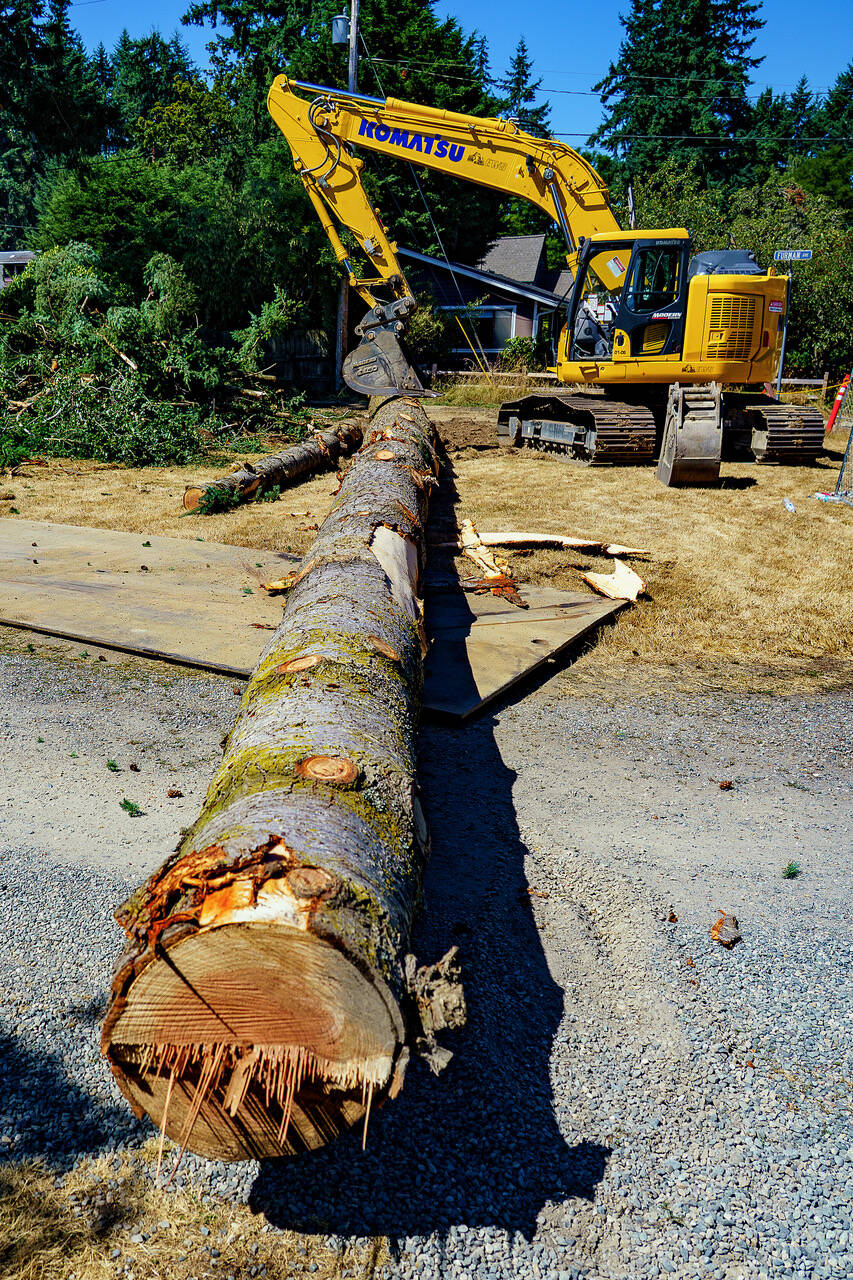Neighbors gathered – some celebrating, some mourning – to watch the removal of six towering Douglas fir trees along Edgecliff Drive in Langley Wednesday and Thursday.
The work occurred as part of the Langley Infrastructure Project, or LIP. The major project years in the making will bring sewer lines out to east Langley, among other utility updates. It is funded by a bond approved by voters in 2019 and a grant from Island County.
In a memo dated July 14, Public Works Director Randi Perry said a removal permit is being sought because the large trees are causing an issue for the project and endangering worker safety. Because of the significant depth of the utilities in this location, alternative trenching methods were not feasible.
In her approval of the permit July 15, Planning Director Meredith Penny wrote that “tree protection cannot be assured while maintaining the function of the utility project. Retaining the trees during construction would compromise worker safety, and even with alternative protection measures, long-term safety for the public, adjacent properties and users of the right-of-way cannot be guaranteed.”
Yet not everyone seems to agree that their removal was necessary. The Whidbey Environmental Action Network, known as WEAN, and Rhonda Salerno, a citizen and member of the Langley City Council, both filed appeals this week, calling for work to cease immediately at the site.
Initially, the city took the position that decisions made by the planning department regarding tree removal permits are not appealable, and the appeals from WEAN and Salerno were regarded as merely letters of intent to appeal.
But later, hours after work had begun on Wednesday, Penny invited Salerno to submit an “actual” appeal, which she did so on Thursday. This cost $1,260 — $1,000 of which is being paid by the the Langley Critical Area Alliance — and will use the city’s legal resources to respond. It will also mean that the full appeal will move forward to the city’s hearing examiner for a decision.
That decision, however, will come too late to save the Edgecliff Six, which is what arbor advocates are referring to as the trees that were taken down this week. By Thursday afternoon, all six had come down. About 20 to 25 people attended a vigil at the site for the fallen trees Wednesday night. The large logs attracted the attention of many deer, which came to investigate once the noise of the heavy machinery died down.
“I’m sad that we are losing the trees, but I don’t know what the solution is,” Tom Cable, a neighbor at the scene, said on Wednesday morning. “It seemed to me that when the plan was originally made several years ago — before we ever arrived — they should have taken into account the narrow road.”
The Doug firs were located on private property near Furman Avenue. In her memo, the public works director pointed out that the right-of-way width cannot accommodate the relocation of utilities.
The LIP’s design process evaluated trees near and within the city right-of-way that could be impacted during the installation of underground utilities. Earlier this month, work crews encountered roots, and an alternative method of trenching was put in place to continue progress, though there was the potential for it to cave in given its depth and the area’s sandy soil structure.
Another neighbor, Bob Arndt, recounted a harrowing story of a man who lived in another part of Langley who narrowly missed getting crushed by a tree that fell on his roof in the middle of the night. He worried about something similar happening to the three little girls who live in the house closest to the massive trees, which were estimated, based on historic photos‚ to have been planted sometime in the 1960s.
“I think that because of their location and the conflict with the sewer line that they would be incredibly dangerous not to take them down,” Arndt said.
Yet advocates cited various environmental reasons for keeping the trees around, including the stabilization of Edgecliff’s bluff, stormwater retention, carbon sequestration and wildlife habitat.
Marnie Jackson, executive director of WEAN, wrote in her letter of intent to appeal that cities like Seattle demonstrate that infrastructure projects can successfully proceed while preserving mature trees and ensuring worker safety.
“This is achieved through less destructive techniques such as precision air or hydro excavation, horizontal directional boring and specialized shoring systems designed to accommodate root structures,” she said.
Salerno said she was sickened to see these perfectly healthy trees removed. She noted that the city is not following aspects of its own tree ordinance, including a section that requires a notice sign to be posted on site at least three days before tree removal begins. In an email to the Record, the planning director acknowledged the sign was not posted three days in advance, and this was an oversight on her part.
Salerno’s appeal could potentially have an impact on the further removal of trees that are impeding progress of the LIP. In an interview Thursday, Langley Mayor Kennedy Horstman said the appeal is a good thing for the city because it’s a bad thing to have disagreement around code. She added that it’s important to be aware of what is appropriate and legal, and that she had a respectful conversation with Salerno earlier about the issue.
Horstman said there are misconceptions being repeated throughout the community, however, about the process.
“The city and the contractor absolutely followed the defined protocols for tree protection,” she said.
An arborist determined it is more likely than not that the trees would be impacted by the installation of utilities, though he did also say damage to the roots of the trees could be mitigated.
Gail Fleming, another member of the city council who lives near the removal site, said her thoughts are focused on the protection of other big trees on Edgecliff Drive from Furman Avenue down to the city limits.
“The plans are for a stormwater pipe to be installed on the north side of the road — right near six huge cedars and three huge Douglas firs, among other significant trees,” she said in an email. “I do not want to see a repeat of what happened on Furman. I will be working to bring awareness to this situation so that we can ensure the preservation of those trees.”
Jackson expressed a similar sentiment.
“Each tree needs to be handled with care and in compliance with the tree ordinance, given the ecological and bluff stabilization significance of these trees and their complex root systems,” she wrote in an email. “The potential cumulative impact of this kind of decision-making is alarming, considering all the trees in the path of this project.”
According to the city’s tree code, replacement trees for the Edgecliff Six must be planted in late fall or early spring to maximize survival success.



